2010 Hyundai H-100 Truck ECU
[x] Cancel search: ECUPage 6 of 207
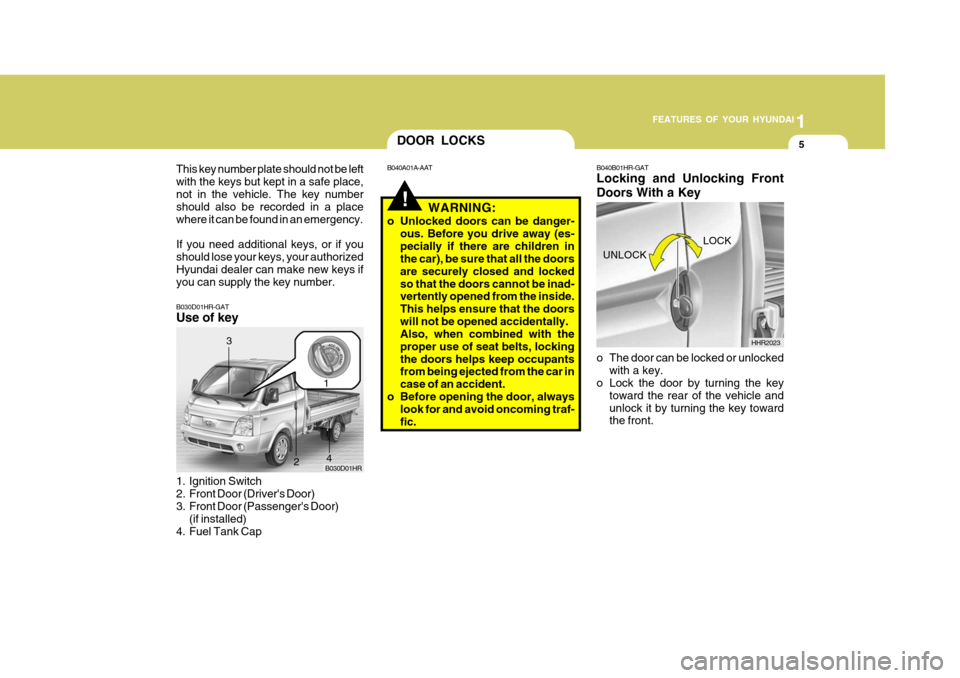
1
FEATURES OF YOUR HYUNDAI
5
B030D01HR-GAT Use of key
1. Ignition Switch
2. Front Door (Driver's Door)
3. Front Door (Passenger's Door)
(if installed)
4. Fuel Tank Cap B030D01HR
1
2
3
4
!
DOOR LOCKS
B040A01A-AAT
WARNING:
o Unlocked doors can be danger- ous. Before you drive away (es- pecially if there are children in the car), be sure that all the doors are securely closed and lockedso that the doors cannot be inad- vertently opened from the inside. This helps ensure that the doorswill not be opened accidentally. Also, when combined with the proper use of seat belts, lockingthe doors helps keep occupants from being ejected from the car in case of an accident.
o Before opening the door, always look for and avoid oncoming traf-fic.
UNLOCK
HHR2023
LOCK
B040B01HR-GAT Locking and Unlocking Front Doors With a Key
o The door can be locked or unlocked
with a key.
o Lock the door by turning the key
toward the rear of the vehicle and unlock it by turning the key toward the front.
This key number plate should not be left with the keys but kept in a safe place,not in the vehicle. The key number should also be recorded in a place where it can be found in an emergency. If you need additional keys, or if you should lose your keys, your authorizedHyundai dealer can make new keys if you can supply the key number.
Page 14 of 207
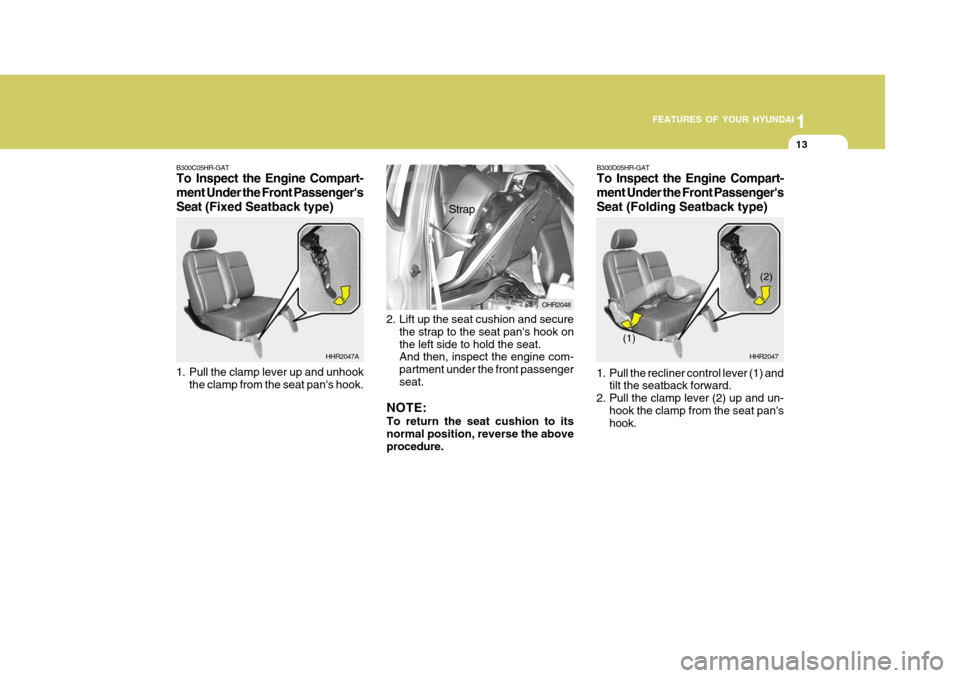
1
FEATURES OF YOUR HYUNDAI
13
1. Pull the clamp lever up and unhook
the clamp from the seat pan's hook. HHR2047A
B300C05HR-GAT
To Inspect the Engine Compart- ment Under the Front Passenger's
Seat (Fixed Seatback type)
2. Lift up the seat cushion and secure
the strap to the seat pan's hook on the left side to hold the seat. And then, inspect the engine com- partment under the front passengerseat.
NOTE: To return the seat cushion to its normal position, reverse the aboveprocedure. OHR2048
Strap
B300D05HR-GAT
To Inspect the Engine Compart- ment Under the Front Passenger's
Seat (Folding Seatback type)
HHR2047
(1) (2)
1. Pull the recliner control lever (1) and tilt the seatback forward.
2. Pull the clamp lever (2) up and un- hook the clamp from the seat pan's hook.
Page 15 of 207
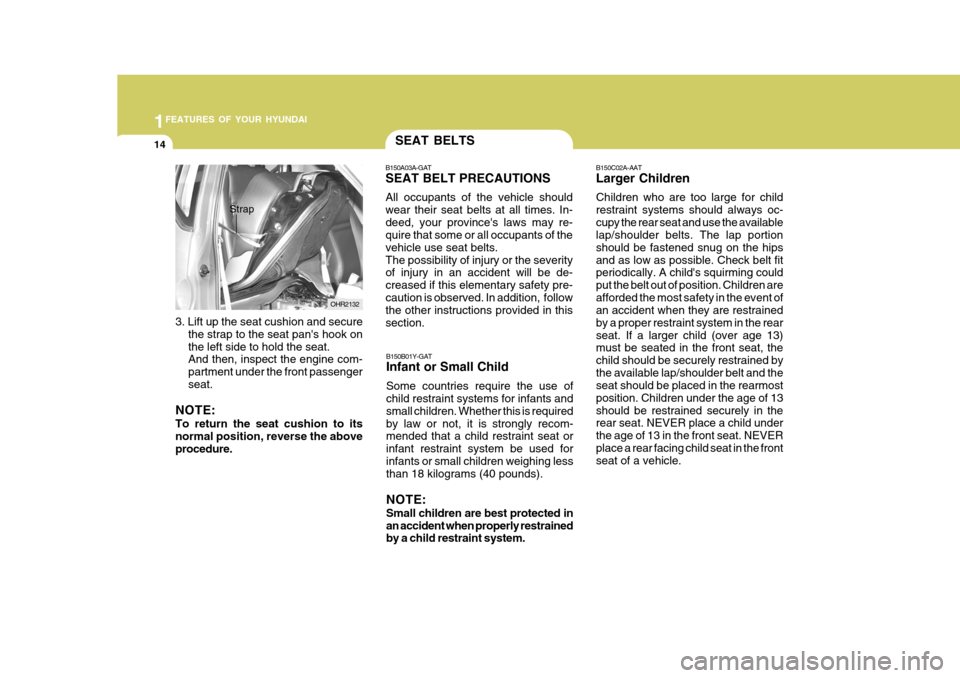
1FEATURES OF YOUR HYUNDAI
14
B150C02A-AAT Larger Children Children who are too large for child restraint systems should always oc-cupy the rear seat and use the available lap/shoulder belts. The lap portion should be fastened snug on the hipsand as low as possible. Check belt fit periodically. A child's squirming could put the belt out of position. Children areafforded the most safety in the event of an accident when they are restrained by a proper restraint system in the rearseat. If a larger child (over age 13) must be seated in the front seat, the child should be securely restrained bythe available lap/shoulder belt and the seat should be placed in the rearmost position. Children under the age of 13should be restrained securely in the rear seat. NEVER place a child under the age of 13 in the front seat. NEVERplace a rear facing child seat in the front seat of a vehicle.SEAT BELTS
B150A03A-GAT SEAT BELT PRECAUTIONS All occupants of the vehicle should wear their seat belts at all times. In-deed, your province's laws may re- quire that some or all occupants of the vehicle use seat belts.The possibility of injury or the severity of injury in an accident will be de- creased if this elementary safety pre-caution is observed. In addition, follow the other instructions provided in this section.
B150B01Y-GAT Infant or Small Child Some countries require the use of child restraint systems for infants and small children. Whether this is requiredby law or not, it is strongly recom- mended that a child restraint seat or infant restraint system be used forinfants or small children weighing less than 18 kilograms (40 pounds). NOTE: Small children are best protected in an accident when properly restrained by a child restraint system.
OHR2132
3. Lift up the seat cushion and secure the strap to the seat pan's hook on the left side to hold the seat. And then, inspect the engine com- partment under the front passengerseat.
NOTE: To return the seat cushion to its normal position, reverse the aboveprocedure.
Strap
Page 20 of 207
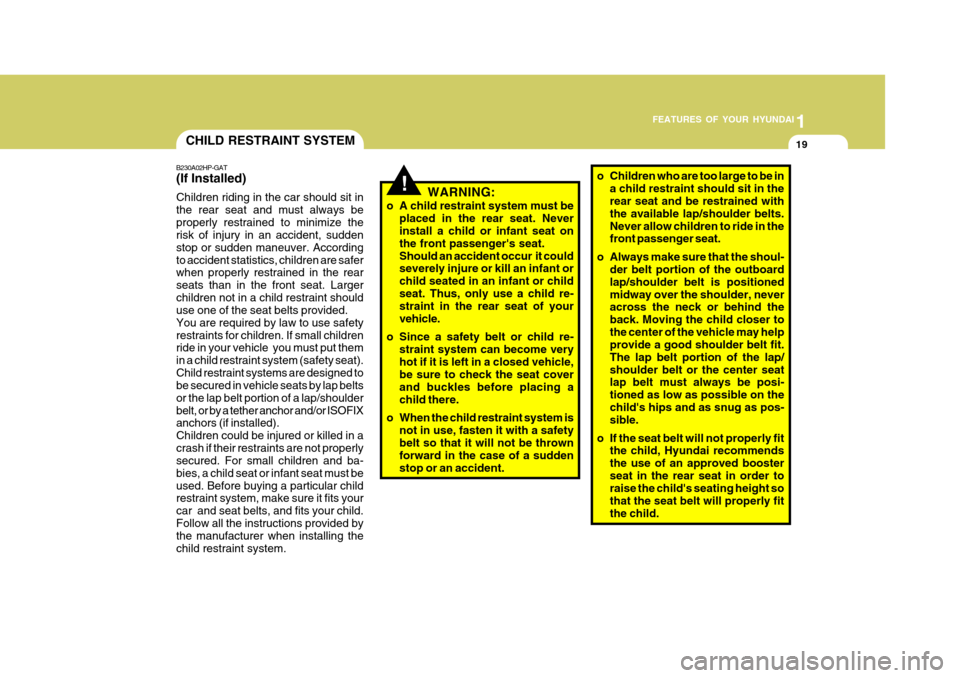
1
FEATURES OF YOUR HYUNDAI
19
WARNING:
o A child restraint system must be placed in the rear seat. Never install a child or infant seat on the front passenger's seat.Should an accident occur it could severely injure or kill an infant or child seated in an infant or childseat. Thus, only use a child re- straint in the rear seat of your vehicle.
o Since a safety belt or child re- straint system can become veryhot if it is left in a closed vehicle, be sure to check the seat cover and buckles before placing achild there.
o When the child restraint system is not in use, fasten it with a safety belt so that it will not be thrown forward in the case of a suddenstop or an accident.!
CHILD RESTRAINT SYSTEM
B230A02HP-GAT (If Installed) Children riding in the car should sit in the rear seat and must always beproperly restrained to minimize the risk of injury in an accident, sudden stop or sudden maneuver. Accordingto accident statistics, children are safer when properly restrained in the rear seats than in the front seat. Largerchildren not in a child restraint should use one of the seat belts provided. You are required by law to use safetyrestraints for children. If small children ride in your vehicle you must put them in a child restraint system (safety seat).Child restraint systems are designed to be secured in vehicle seats by lap belts or the lap belt portion of a lap/shoulderbelt, or by a tether anchor and/or ISOFIX anchors (if installed). Children could be injured or killed in acrash if their restraints are not properly secured. For small children and ba- bies, a child seat or infant seat must beused. Before buying a particular child restraint system, make sure it fits your car and seat belts, and fits your child.Follow all the instructions provided by the manufacturer when installing the child restraint system.
o Children who are too large to be in a child restraint should sit in the rear seat and be restrained with the available lap/shoulder belts.Never allow children to ride in the front passenger seat.
o Always make sure that the shoul- der belt portion of the outboard lap/shoulder belt is positionedmidway over the shoulder, never across the neck or behind the back. Moving the child closer tothe center of the vehicle may help provide a good shoulder belt fit. The lap belt portion of the lap/shoulder belt or the center seat lap belt must always be posi- tioned as low as possible on thechild's hips and as snug as pos- sible.
o If the seat belt will not properly fit the child, Hyundai recommends the use of an approved boosterseat in the rear seat in order to raise the child's seating height so that the seat belt will properly fitthe child.
Page 21 of 207
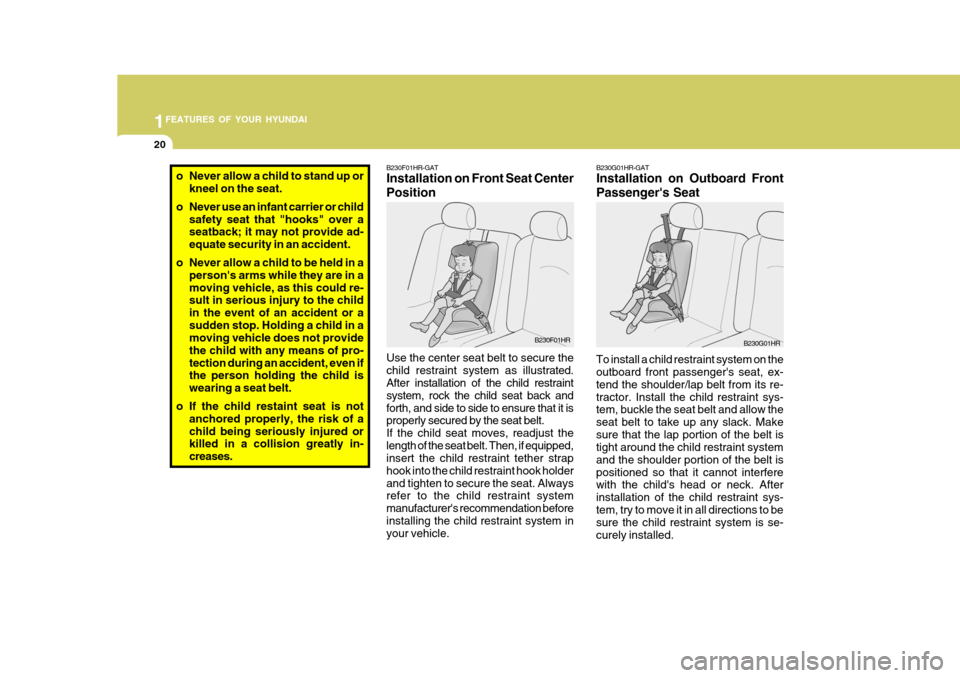
1FEATURES OF YOUR HYUNDAI
20
To install a child restraint system on the outboard front passenger's seat, ex- tend the shoulder/lap belt from its re-tractor. Install the child restraint sys- tem, buckle the seat belt and allow the seat belt to take up any slack. Makesure that the lap portion of the belt is tight around the child restraint system and the shoulder portion of the belt ispositioned so that it cannot interfere with the child's head or neck. After installation of the child restraint sys-tem, try to move it in all directions to be sure the child restraint system is se- curely installed.B230G01HR-GAT Installation on Outboard Front Passenger's Seat
B230G01HR
B230F01HR-GAT Installation on Front Seat Center Position Use the center seat belt to secure the child restraint system as illust rated.
After installation of the child restraintsystem, rock the child seat back andforth, and side to side to ensure that it is properly secured by the seat belt. If the child seat moves, readjust thelength of the seat belt. Then, if equipped, insert the child restraint tether strap hook into the child restraint hook holderand tighten to secure the seat. Always refer to the child restraint system manufacturer's recommendation beforeinstalling the child restraint system in your vehicle. B230F01HRo Never allow a child to stand up or
kneel on the seat.
o Never use an infant carrier or child safety seat that "hooks" over a seatback; it may not provide ad- equate security in an accident.
o Never allow a child to be held in a person's arms while they are in amoving vehicle, as this could re- sult in serious injury to the child in the event of an accident or asudden stop. Holding a child in a moving vehicle does not provide the child with any means of pro-tection during an accident, even if the person holding the child is wearing a seat belt.
o If the child restaint seat is not anchored properly, the risk of achild being seriously injured or killed in a collision greatly in- creases.
Page 49 of 207

1FEATURES OF YOUR HYUNDAI
48
!WARNING:
o Make sure to refuel your vehicle according to the "Fuel require- ments" suggested in section 1.
o Fuel vapors are dangerous. Be-
fore refueling, always stop theengine and never allow sparks or open flames near the tank area. If you need to replace the tank cap,use a genuine Hyundai replace- ment part. If you open the fuel tank cap dur-ing high ambient temperatures, a slight "pressure sound" may be heard. This is normal and not acause for concern. Whenever you open the fuel tank cap, turn it slowly.
o Automotive fuels are flammable/ explosive materials. When refuel-ing, please note the followingguidelines carefully.
- Before touching the fuel nozzle or
fuel tank cap, have one's hands incontact with metal parts away from the tank neck to discharge static electricity.
FUEL TANK CAP
B560A03HR-GAT
The fuel tank cap is located at the left side of the vehicle body. The fuel tank cap can be unlocked by turning the key counterclockwise.To lock the fuel tank cap, turn it clock- wise until it locks into place. NOTE: If the fuel tank cap will not open because ice has formed around it, tap lightly on the cap to break the iceand release the cap. If necessary, spray around the cap with an ap- proved de-icer fluid (do not use ra-diator anti-freeze) or move the ve- hicle to a warm place and allow the ice to melt. HHR2036
- Do not get back in the vehicle
while refueling. Do not operateanything that can produce static electricity. Static electricity dis- charge can ignite fuel vapors re-sulting in an explosion.
- When using a portable fuel con-
tainer, be sure to place the con-tainer on the ground while refuel- ing. Static electricity discharge from the container can ignite fuelvapors causing a fire. While start- ing refueling, contact should be maintained until the filling is com-plete.
- Do not use cellular phones around
a gas station. The electric currentor electronic interference from cel- lular phones can ignite fuel va- pors causing a fire.
- When refueling, always turn the engine off. Sparks by engine com-partment electrical equipment canignite fuel vapors causing a fire. After refueling, check to make sure the fuel tank cap is securely closed,and then start the engine.
- Do not smoke or try to light ciga-
rettes around a gas station. Auto-motive fuels are flammable.
Page 119 of 207

2 DRIVING YOUR HYUNDAI
16
C190D01A-GAT Safety Chains Should the hitch connection between your car and the trailer or vehicle you are towing fail, the trailer or vehicle could wander dangerously across otherlanes of traffic and ultimately collide with another vehicle. To eliminate this potentially dangerous situation, safetychains, attached between your car and the trailer or towed vehicle, are re- quired in most provinces.and allow the engine to idle until it cools down. You may proceed once the engine has cooled suffi-ciently.
C190C03S-GAT Trailer Brakes If your trailer is equipped with a braking system, make sure it conforms to fed-eral and/or local regulations and that it is properly installed and operating cor- rectly. NOTE: If you tow a trailer or vehicle, your car will require more frequent main-tenance due to the additional load. See "Maintenance Under Severe Usage Conditions" on page 5-8.
CAUTION:
o Never connect a trailer brake sys- tem directly to the vehicle brakesystem.
o When towing a trailer on steep
grades (in excess of 6%) pay closeattention to the engine coolant temperature gauge to ensure the engine does not overheat. If theneedle of the coolant temperature gauge moves across the dial to- wards "H" (HOT), pull over andstop as soon as it is safe to do so,
!
C190B01S-AAT Trailer Hitches Select the proper hitch and ball combi- nation, making sure that it's location iscompatible with that of the trailer or vehicle being towed. Use a quality non-equalizing hitch whichdistributes the tongue load uniformly throughout the chassis. The hitch should be bolted securely to the car and installed by a qualified technician. DO NOT USE A HITCHDESIGNED FOR TEMPORARY IN- STALLATION AND NEVER USE ONE THAT ATTACHES ONLY TO THEBUMPER.
Page 121 of 207

2 DRIVING YOUR HYUNDAI
18
8. When parking your car and trailer,especially on a hill, be sure to fol- low all the normal precautions. Turn your front wheel into the curb, set the parking brake firmly, and putthe transmission in 1st or Reverse. In addition, place wheel chocks at each of the trailer's tires.
9. If the trailer has electric brakes, start your vehicle and trailer mov-ing, and then apply the trailer brakecontroller by hand to be sure the brakes are working. This lets you check your electrical connection atthe same time.
10. During your trip, check occasion-
ally to be sure that the load issecure, and that the lights and any trailer brakes are still working.
11. Avoid jerky starts, sudden accel- eration or sudden stops.
12. Avoid sharp turns and rapid lane
changes.
13. Avoid holding the brake pedal down too long or too frequently. This could cause the brakes to over-heat, resulting in reduced braking efficiency.
!WARNING:
Improperly loading your car and trailer can seriously affect its steer- ing and braking performance caus- ing a crash which could cause seri-ous injury or death. C190F01HR-GAT Trailer or Vehicle Towing Tips
1. Before towing, check hitch and
safety chain connections as well as proper operation of the trailer running lights, brake lights, and turn signals.
2. Always drive your vehicle at a mod- erate speed (Less than 100 km/h).
3. Trailer towing requires more fuel than normal conditions.
4. To maintain engine braking effi-
ciency, do not tow a trailer withtransmission in fifth gear.
5. Always secure items in the trailer
to prevent load shift while driving.
6. Check the condition and air pres- sure of all tires on the trailer andyour car. Low tire pressure canseriously affect the handling. Also check the spare tire.
7. The vehicle/trailer combination is more affected by crosswind andbuffeting. When being passed by a largevehicle, keep a constant speed and steer straight ahead. If there is too much wind buffeting, slow downto get out of the other vehicle's air turbulence.